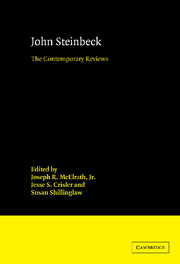Book contents
- Frontmatter
- Contents
- Series Editor's Preface
- Introduction
- 1 Cup of Gold (1929)
- 2 The Pastures of Heaven (1932)
- 3 To a God Unknown (1933)
- 4 Tortilla Flat (1935)
- 5 In Dubious Battle (1936)
- 6 Of Mice and Men (the novel, 1937)
- 7 The Red Pony (1937)
- 8 Of Mice and Men (the play, 1937)
- 9 The Long Valley (1938)
- 10 The Grapes of Wrath (1939)
- 11 The Forgotten Village (1941)
- 12 Sea of Cortez (1941)
- 13 The Moon Is Down (the novel, 1942)
- 14 The Moon Is Down (the play, 1942)
- 15 Bombs Away (1942)
- 16 Cannery Row (1945)
- 17 The Wayward Bus (1947)
- 18 The Pearl (1947)
- 19 A Russian Journal (1948)
- 20 Burning Bright (the novel, 1950)
- 21 Burning Bright (the play, 1950)
- 22 The Log from the Sea of Cortez (1951)
- 23 East of Eden (1952)
- 24 Sweet Thursday (1954)
- 25 The Short Reign of Pippin IV (1957)
- 26 Once There Was a War (1958)
- 27 The Winter of Our Discontent (1961)
- 28 Travels with Charley in Search of America (1962)
- 29 America and Americans (1966)
- 30 Journal of a Novel: The East of Eden Letters (1969)
- 31 The Acts of King Arthur and His Noble Knights (1976)
- 32 Working Days: The Journals of The Grapes of Wrath 1938–1941 (1989)
- Index
21 - Burning Bright (the play, 1950)
Published online by Cambridge University Press: 03 May 2010
- Frontmatter
- Contents
- Series Editor's Preface
- Introduction
- 1 Cup of Gold (1929)
- 2 The Pastures of Heaven (1932)
- 3 To a God Unknown (1933)
- 4 Tortilla Flat (1935)
- 5 In Dubious Battle (1936)
- 6 Of Mice and Men (the novel, 1937)
- 7 The Red Pony (1937)
- 8 Of Mice and Men (the play, 1937)
- 9 The Long Valley (1938)
- 10 The Grapes of Wrath (1939)
- 11 The Forgotten Village (1941)
- 12 Sea of Cortez (1941)
- 13 The Moon Is Down (the novel, 1942)
- 14 The Moon Is Down (the play, 1942)
- 15 Bombs Away (1942)
- 16 Cannery Row (1945)
- 17 The Wayward Bus (1947)
- 18 The Pearl (1947)
- 19 A Russian Journal (1948)
- 20 Burning Bright (the novel, 1950)
- 21 Burning Bright (the play, 1950)
- 22 The Log from the Sea of Cortez (1951)
- 23 East of Eden (1952)
- 24 Sweet Thursday (1954)
- 25 The Short Reign of Pippin IV (1957)
- 26 Once There Was a War (1958)
- 27 The Winter of Our Discontent (1961)
- 28 Travels with Charley in Search of America (1962)
- 29 America and Americans (1966)
- 30 Journal of a Novel: The East of Eden Letters (1969)
- 31 The Acts of King Arthur and His Noble Knights (1976)
- 32 Working Days: The Journals of The Grapes of Wrath 1938–1941 (1989)
- Index
Summary
Brooks Atkinson.
“At the Theatre.”
New York Times,
19 October 1950, p. 40.
Credit John Steinbeck with having the courage to try something that is difficult. Credit four actors and a director with a superb performance. For Burning Bright, which opened at the Broadhurst last evening, is written in the form of an epic and acted like a poem.
But there is always a “but” at the end of such salutations. Although Mr. Steinbeck is a man of faith, he does not write with the majesty of a prophet and Burning Bright does not have much eloquence in the theatre. Mr. Steinbeck has been happier when he has been closer to mice and men and the itinerant Okies. Abstract ideas do not appear to be his medium.
Like the preacher in Ecclesiastes, he says that the earth abideth forever. The human race must go on, though the method does not matter. To illustrate his thesis he offers a middle-aged husband, a young wife, a friend of the family and a young lover. Although the husband is sterile, he longs for children to continue the inheritance he has had from his forebears. Descendants are a religious obligation to him.
To gratify his vanity, the wife secretly takes a lover and pretends that the child is her husband's. When he discovers that he has been deceived, he is crushed and horrified. But in the end, Mr. Steinbeck shows the husband as resigned to any method that keeps the chain of life unbroken.
To give his theme a universal significance Mr. Steinbeck presents his characters first as circus folk, second as farmers and third as sailors.
- Type
- Chapter
- Information
- John SteinbeckThe Contemporary Reviews, pp. 355 - 368Publisher: Cambridge University PressPrint publication year: 1996



